Search By Model |
| 2012 Current Models |
| Compact Crossover |
| Patriot |
| Compass |
| Compact Suv |
| Liberty |
| Mid-Size SUV |
| Grand Cherokee |
| Off-Road |
| Wrangler |
| Wrangler Unlimited |
Jeep' is an automobile marque of Chrysler. It is the oldest off-road vehicle (also sport utility vehicle—SUV) brand. It inspired a number of other military light utility vehicles, such as the Land Rover which is the second oldest 4-wheel-drive brand. The original Jeep vehicle that first appeared as the prototype Bantam BRC became the primary light 4-wheel-drive vehicle of the United States Army and Allies during World War II, as well as the postwar period. Many Jeep variants serving similar military and civilian roles have since been created in other nations.
History

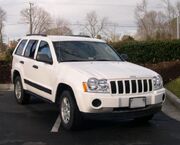
Origin of the name
There are many explanations of the origin of the word jeep, all of which have proven difficult to verify. The most widely held theory is that the military designation of GP begat the term Jeep and holds that the vehicle bore the designation GP (for Government Purposes or General Purpose), which was phonetically slurred into the word jeep. However, an alternate view launched by R. Lee Ermey, on his television series Mail Call, disputes this, saying that the vehicle was designed for specific duties, and was never referred to as "General Purpose" and it is highly unlikely that the average jeep-driving GI would have been familiar with this designation. The Ford GPW abbreviation actually meant (G for government use, P to designate its {80 in wheelbase and W to indicate its Willys-Overland designed engine).
Many, including Ermey, suggest that soldiers at the time were so impressed with the new vehicles that they informally named it after Eugene the Jeep, a character in the Popeye cartoons created by E. C. Segar. Eugene the Jeep was Popeye's "jungle pet" and was "small, able to move between dimensions and could solve seemingly impossible problems."[1]
Words of the Fighting Forces by Clinton A. Sanders, a dictionary of military slang, published in 1942, in the library at The Pentagon gives this definition:
- Jeep: A four-wheel drive vehicle of one-half- to one-and-one-half-ton capacity for reconnaissance or other army duty. A term applied to the bantam-cars, and occasionally to other motor vehicles (U.S.A.) in the Air Corps, the Link Trainer; in the armored forces, the ½-ton command vehicle. Also referred to as "any small plane, helicopter, or gadget."
This definition is supported by the use of the term "jeep carrier" to refer to the Navy's small escort carriers.
Early in 1941, Willys-Overland demonstrated the vehicle's off-road capability by having it drive up the steps of the United States Capitol, driven by Willys test driver Irving "Red" Haussman, who had recently heard soldiers at Fort Holabird calling it a "jeep." When asked by syndicated columnist Katherine Hillyer for the Washington Daily News (or by a bystander, according to another account) what it was called, Irving answered, "It's a jeep."
Katherine Hillyer's article was published nationally on February 20, 1941, and included a picture of the vehicle with the caption:
- LAWMAKERS TAKE A RIDE- With Senator Meade, of New York, at the wheel, and Representative Thomas, of New Jersey, sitting beside him, one of the Army's new scout cars, known as "jeeps" or "quads", climbs up the Capitol steps in a demonstration yesterday. Soldiers in the rear seat for gunners were unperturbed.
This exposure caused all other jeep references to fade, leaving the 4x4 with the name. The term was also in military slang use to mean vehicles that were untried, or untested.
Trade name
The original trademark brand-name application was filed in February 1943 by Willys-Overland.[2] It is also used as a generic term with a lowercase (jeep) for vehicles inspired by the Jeep that are suitable for use on rough terrain.[3]
As the only company that continually produced Jeep vehicles after the war, in June 1950 Willys-Overland was granted the privilege of owning the name "Jeep" as a registered trademark.[2]
The name "Jeep" was also for many years used in Popeye as the odd critter Eugene from the King Features Syndicate television show of the 1960s, and for a 1960s group Jeep, in the same mold as The Merry-Go Round("Live"), The Strawberry Alarm Clock ("Incense and Peppermint"), who had a flop single that got some airplay on the radio in the US, "Feep Feep".
The origins of the vehicle: the first jeeps
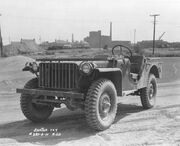
Bantam BRC 40
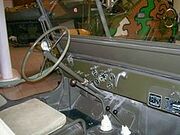
Dashboard of World War II era jeep.
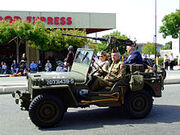
Jeep with 50 cal. Browning machine gun
When it became obvious that the United States was eventually going to become involved in the war raging in Europe, the U.S. Army contacted 135 companies asking for working prototypes of a four-wheel-drive reconnaissance car. Only two companies responded to the request, The American Bantam Car Company and Willys-Overland. The Army had set what seemed like an impossible deadline of 49 days to supply a working prototype. Willys asked for more time but were refused. The bankrupt American Bantam Car Company had no engineering staff left on the payroll and brought in Karl Probst, a talented freelance designer from Detroit. After turning down an initial request from Bantam, Probst accepted the job after being asked again by the Army, and initially working without salary, went to work July 17, 1940.
Probst completely laid out plans for the Bantam prototype in two days, and the next day estimated the total cost of the vehicle. On July 22, Bantam's bid was submitted, complete with blueprints.[4] Much of the vehicle had to be assembled from existing off-the-shelf automotive parts, and the custom four-wheel drivetrain components were supplied by Spicer. The hand-built prototype was completed in Butler, Pennsylvania,[5] and driven to Camp Holabird, Maryland, for testing by the Army on 21 September 1940. The vehicle met the Army's criteria, but its engine did not meet the Army's torque requirements.
The Army felt that the Bantam company was too small to supply the number of vehicles it needed, so it supplied the Bantam design to Willys and Ford who were encouraged to make their own changes and modifications. The resulting Ford "Pygmy" and Willys "Quad" prototypes looked very similar to the Bantam BRC (Bantam Reconnaissance Car) prototype and Spicer supplied very similar four-wheel drivetrain components to all three manufacturers.
Fifteen hundred of each of the three models were built and extensively field-tested. Willys-Overland's chief engineer Delmar "Barney" Roos made design changes to meet a revised weight specification (a maximum of 1275 lb[6] including oil and water). He was thus able to use the powerful but comparatively heavy Willys "Go Devil" engine, and win the initial production contract. The Willys version of the car would become the standardized jeep design, designated the model MB and was built at their plant in Toledo, Ohio. The familiar pressed metal Jeep grille was actually a Ford design feature and incorporated into the final design by the Army.
Since the War Department required a large number of vehicles to be manufactured in a relatively short time, Willys-Overland granted the United States Government a non-exclusive license to allow another company to manufacture vehicles using Willys' specifications. The Army chose Ford as the second supplier, but building Jeeps to the Willys' design. Willys supplied Ford with a complete set of plans and specifications. American Bantam, the creators of the first Jeep, spent the rest of the war building heavy-duty trailers for the Army.
Final production version Jeeps built by Willys-Overland were the Model MB, while those built by Ford were the Model GPW (G = government vehicle, P designated the 80" wheelbase, and W = the Willys engine design). There were subtle differences between the two.[7] The versions produced by Ford had every component (including bolt heads) marked with an "F". Willys also followed the Ford pattern by stamping its name into some body parts, but stopped this in 1942.[8] The cost per vehicle trended upwards as the war continued from the price under the first contract from Willys at US$648.74 (Ford's was $782.59 per unit).[9] Willys-Overland and Ford, under the direction of Charles E. Sorensen (Vice-President of Ford during World War II), produced about 640,000 Jeeps between them, which was about 18% of all the wheeled military vehicles built in the U.S. during the war.
Jeeps were used by every division of the U.S. military and an average of 145 were supplied to every infantry regiment. Jeeps were used for many other purposes including cable laying, saw milling, as firefighting pumpers, field ambulances, tractors and, with suitable wheels, would even run on railway tracks. An amphibious jeep, the model GPA, or "seep" (Sea Jeep) was built for Ford in modest numbers but it could not be considered a huge success—it was neither a good off-road vehicle nor a good boat. As part of the war effort, nearly 30% of all Jeep production was supplied to Great Britain and to the Soviet Red Army during World War II. During the jeep's service in Korea, the name was referred to as "Just Enough Essential Parts" by the troops due to the very basic design.
The Jeep has been widely imitated around the world, including in France by Delahaye and by Hotchkiss et Cie (after 1954, Hotchkiss manufactured Jeeps under license from Willys), and in Japan by Mitsubishi Motors and Toyota. The utilitarian good looks of the original Jeep have been hailed by industrial designers and museum curators alike. The Museum of Modern Art described the Jeep as a masterpiece of functionalist design, and has periodically exhibited the Jeep as part of its collection.[10][11] Ernie Pyle called the Jeep, along with the Coleman G.I. Pocket Stove, "the two most important pieces of noncombat equipment ever developed."[12] Jeeps became even more famous following the war, as they became available on the surplus market. Some ads claimed to offer "Jeeps still in the factory crate." This legend persisted for decades, despite the fact that Jeeps were never shipped from the factory in crates.
Another legend—true, in this case—rising around the Jeep comes from the Jeepney, a unique type of taxi or bus created in the Philippines. The first Jeepneys were military-surplus MB and GPWs, left behind in the war-ravaged country following World War II and Filipino independence. Jeepneys were built from Jeeps by lengthening and widening the rear "tub" of the vehicle, allowing more passengers to ride. Over the years, Jeepneys have become the most ubiquitous symbol of the modern Philippines, even as they have been decorated in more elaborate and flamboyant styles by their owners.
In the United States military, the jeep has been supplanted by a number of vehicles (e.g. Ford's M151 MUTT) of which the latest is the High Mobility Multipurpose Wheeled Vehicle (HMMWV or "Humvee").
The M715
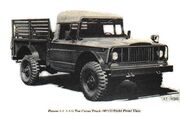
Jeep M715
In 1965, Jeep developed the M715 1.25-ton army truck, a militarized version of the civilian J-series Jeep truck, which served extensively in Vietnam. It had heavier full-floating axles and a foldable vertical flat windshield. Today, it serves other countries, and is still being produced by Kia under license.
The CJ ("Civilian Jeep") series began in 1945 with the CJ-2A followed by the CJ-3B in 1953. These early Jeeps are commonly referred to as "flatfenders" because their front fenders were flat across the front, the same as their military precedents, the Willys MB and identical Ford GPW models. The CJ-4 exists only as a 1951 prototype, and is the missing link between the flat-fendered CJ-2A and CJ-3B and the round-fendered CJ-5 first introduced in 1955.
The Jeep marque
The marque has gone through many owners, starting with Willys, which produced the first Civilian Jeep (CJ) in 1945 and who were the first granted the trademark in 1950. Willys was sold to Kaiser Motors in 1953, which became Kaiser-Jeep in 1963. American Motors Corporation (AMC) purchased Kaiser's money-losing Jeep operations in 1970. The utility vehicles complemented AMC's passenger car business by sharing components, achieving volume efficiencies, as well as capitalizing on Jeep's international and government markets.
The French automaker Renault began investing in AMC in 1979. However, by 1987, the automobile markets had changed and even Renault itself was experiencing financial troubles. At the same time, Chrysler Corporation wanted to capture the Jeep brand, as well as other assets of AMC. Chrysler bought out AMC in 1987, shortly after the Jeep CJ-7 was replaced with the AMC-designed Jeep Wrangler or YJ. Chrysler merged with Daimler-Benz in 1998 to form DaimlerChrysler. DaimlerChrysler eventually sold most of their interest in Chrysler to a private equity company in 2007. Chrysler and the Jeep division now operate under the name Chrysler Group LLC.
Jeeps have been built under licence by various manufacturers around the world including Mahindra in India, EBRO in Spain, and several in South America. Mitsubishi built more than 30 different Jeep models in Japan between 1953 and 1998. Most of them were based on the CJ-3B model of the original Willys-Kaiser design.[13]
Toledo, Ohio has been the headquarters of the Jeep marque since its inception, and the city has always been proud of this heritage. Although no longer produced in the same Toledo Complex as the World War II originals, two streets in the vicinity of the old plant are named Willys Parkway and Jeep Parkway.
American Motors set up the first automobile-manufacturing joint venture in the People's Republic of China on January 15, 1984.[14] The result was Beijing Jeep Corporation, Ltd., in partnership with Beijing Automobile Industry Corporation, to produce the Jeep Cherokee (XJ) in Beijing. Manufacture continued after Chrysler's buyout of AMC. This joint venture is now part of DaimlerChrysler and DaimlerChrysler China Invest Corporation. The original 1984 XJ model was updated and called the "Jeep 2500" toward the end of its production that ended after 2005.[15]
A division of Chrysler Group LLC, the most recent successor company to the Jeep brand, now holds trademark status on the name "Jeep" and the distinctive 7-slot front grille design. The original 9-slot grille associated with all World War II jeeps was designed by Ford for their GPW, and because it weighed less than the original "Slat Grille" of Willys (an arrangement of flat bars), was incorporated into the "standardized jeep" design.
AM General
The history of the HMMWV (Humvee) has ties with Jeep. In 1971, Jeep's Defense and Government Products Division was turned into AM General, a wholly owned subsidiary of American Motors Corporation, which also owned Jeep. In 1979, while still owned by American Motors, AM General began the first steps toward designing the High Mobility Multipurpose Wheeled Vehicle. AM General also continued manufacturing the two-wheel-drive DJ, which Jeep created in 1953.
The General Motors Hummer and Chrysler Jeep have been waging battle in U.S. courts over the right to use seven slots in their respective radiator grills. Chrysler Jeep claims it has the exclusive rights to use the seven vertical slits since it is the sole remaining assignee of the various companies since Willys gave their postwar jeeps seven slots instead of Ford's nine-slot design for the Jeep.
Off-road abilities

Jeep Wrangler off-roading
Jeep advertising has always emphasized the vehicle's off-road capabilities.[16] Today, the Wrangler is one of the few remaining four-wheel-drive vehicles with solid front and rear axles. These axles are known for their durability and strength. Most Wranglers come with a Dana 35 rear differential and a Dana 30 front differential (a dana 44 front and rear geared to 4:10 in the case of the Rubicon, also with lockers). The upgraded Rubicon model of the JK Wrangler is equipped with electronically activated locking differentials, Dana 44 axles front and rear with 4.10 gears, a 4:1 transfer case, electronic sway bar disconnect and heavy duty suspension.
Another benefit of solid axle vehicles is they tend to be easier and cheaper to "lift" with aftermarket suspension systems. This increases the distance between the axle and chassis of the vehicle. By increasing this distance, larger tires can be installed, which will increase the ground clearance, allowing it to traverse even larger and more difficult obstacles. In addition to higher ground clearance, many owners aim to increase suspension articulation or "flex" to give their Jeeps greatly improved off-road capabilities. Good suspension articulation keeps all four wheels in contact with the ground and maintains traction.
Useful features of the smaller Jeeps are their short wheelbases, narrow frames, and ample approach, breakover, and departure angles, allowing them to fit into places where full-size four-wheel drives have difficulty.
Summary of Jeep ownership
- 1941–1953: Willys-Overland
- 1953–1964: Kaiser-Jeep (calling themselves "Willys Motors")
- 1964–1970: Kaiser-Jeep
- 1970–1987: AMC (w/ Renault controlling production in 1986)
- 1987–1998: Chrysler
- 1998–2007: DaimlerChrysler AG
- 2007–2009: Chrysler LLC
- 2009–present: Chrysler Group LLC
Jeep model list
Historical and military models
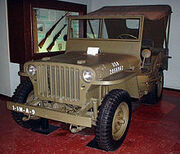
World War II era jeep built by Ford, using the Willys-Overland design
- 1940 Bantam Pilot—Prototype
- 1940 Bantam BRC-60—Prototype
- 1940 Willys Quad—Prototype
- 1940 Ford Pygmy—Prototype
- 1940 Budd Ford—Prototype
- 1941 Ford GP
- 1941 Willys MA
- 1941 Bantam BRC-40
- 1942 Willys MB (slat grille)
- 1942–1945 Willys MB (stamped grille)
- 1942–1945 Ford GPW
- 1942–1943 Ford GPA
- 1944 Willys MLW-1—Prototype (never finished)
- 1944 Willys MLW-2—Prototype
- 1946–1965 Willys Jeep Wagon
- 1947–1965 Willys Jeep Truck
- 1948–1950 VJ—Willys Jeepster
- 1950 X-98—Prototype
- 1953 BC Bobcat—Prototype
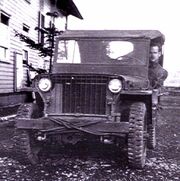
World War II era Willys jeep
- 1950–1955 M-38 (MC)
- 1952–1957 M38A1 (MD)
- 1952–1957 M38A1C
- 1953–1963 M170
- 1955 M38A1D
- 1959–1978 M151 MUTT
- M151A1
- M151A1C
- M151A2
- M718 Ambulance
- M718A1 Ambulance
- M825
- 1960–1968 Jeep M606
- 1956–1965 Jeep Forward Control (Military Variations)
- 1967–1969 Kaiser Jeep M715—based upon the civilian Jeep Gladiator
FC Trucks, VJ Jeepsters, & FJ Vans
- 1948–1950 Willys VJ Jeepster[17]
- 1948–1949 VJ2 Jeepster[18][19]
- 1949–1951 VJ3 Jeepster[20]
- 1949 Alcoa Aluminum-bodied Jeepster Coupe (prototype)[21]
- 1962 The Brazilian Jeepster (prototype)[22][23]
- Jeepster Safari (concept)[24]
(Forward Control Jeep)
(Fleetvan Jeep)
(Commando)
- 1966–1971 C101—Jeepster Commando
- Hurst Jeepster (only 100 produced)
- Hurst Half Cab
- Revival Jeepster
- Commando convertible
- open body roadster
- 1972–1973 C104—Jeep Commando
- Commando Half Cab
CJ models
(Civilian Jeep)

A USPS mail delivery vehicle made by Jeep
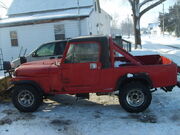
1982 Jeep Scrambler
- 1944 [[|Jeep CJ|Agrijeep CJ-1]]
- 1944–1945 CJ-2
- 1945–1949 CJ-2A
- 1949–1953 CJ-3A
- 1950 CJ-V35
- 1950 CJ-4—Prototype
- 1950 CJ-4M—Prototype
- 1950 CJ-4MA—Prototypes
- 1953–1968 CJ-3B
- 1954–1983 CJ-5
- 1961–1963 Tuxedo Park Mark III
- 1969 Camper
- 1969 462
- 1970 Renegade I
- 1971 Renegade II
- 1972–1983 Renegade Models
- 1973 Super Jeep
- 1977–1979 Golden Eagle
- 1977 Golden Eagle California Edition (available only through California AMC Dealerships)
- 1980 Golden Hawk
- 1979 Silver Anniversary CJ-5 Limited Edition (estimated 1,000 built)
- 1955–1975 CJ-6
- 1955–1968 CJ-3B Long—Spain
- 1960–1977 Jeep Rural—Brazil
- 1964–1967 CJ-5A/CJ-6A Tuxedo Park
- 1976–1986 CJ-7
- 1982 Jamboree Limited Edition (2500 units)
- 1979 CJ-5 Silver Anniversary Limited Edition (estimated 1,000 built)
- 1981–1985 CJ-8 Scrambler
- 1981–1985 CJ-10
DJ models
(Dispatcher Jeep)
- 1955 USAF DJ
- 1955–1964 DJ-3A
- Surrey Gala Package
- 1965–1975 DJ-5
- 1965–1973 DJ-6
- 1967–1975 DJ-5A
- 1970–1972 DJ-5B
- 1973–1974 DJ-5C
- 1975–1976 DJ-5D
- 1976 DJ-5E Electruck
- 1977–1978 DJ-5F
- 1979 DJ-5G
- 1982 DJ-5L
SJ (FSJ) models
(Full Size Jeep)
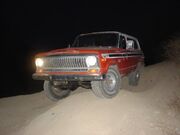
1974 Cherokee S in action
- 1963–1983 SJ Wagoneer
- 1963–1986 J-Series
- Jeep Gladiator
- Pioneer
- Jeep Honcho
- 1977–1979 Jeep Golden Eagle
- 1980–198? Laredo
- 10-4
- 1966–1969 SJ Super Wagoneer
- 1967–1969 Kaiser Jeep M715- based upon the civilian Jeep Gladiator
- 1974–1983 SJ Cherokee
- S
- 1978–1983 Limited
- Classic
- 1976–1983 Chief
- Sport
- Pioneer
- 1980–1983 Laredo
- 1977–1979 Golden Eagle
- 1984–1991 SJ Jeep Grand Wagoneer
- 1991 Final Edition
XJ models
- 1984–2001 XJ Cherokee
- 1984–2001 Base "SE"
- 1984–1988 Chief
- 1984–1990 Pioneer
- 1985–1992 Laredo
- 1987–1992/1998-2001 Limited
- 1988–2001 Sport
- 1991–1992 Briarwood
- 1993–1997 Country
- 1996–2001 Classic
- 1984–1990 XJ Wagoneer
- 1984–1985 Broughwood
- 1984–1990 Limited
MJ models
(Metric Ton Jeep Comanche)
- 1986–1992 MJ Comanche
- 1986 Custom
- 1986 X
- 1986 XLS
- 1987–1992 Base SE
- 1987–1990 Chief
- 1987–1992 Laredo
- 1987–1990 Pioneer
- 1987–1992 SporTruck
- 1987–1992 Eliminator

1997 Jeep Wrangler TJ
YJ, TJ, LJ and JK models
(Jeep Wrangler)
- 1987–1995 Wrangler YJ
- 1991–1993 Renegade
- 1988–1995 Wrangler Long—Venezuela

2005 TJ Rubicon
- 1997–2006 Wrangler TJSe, Sport, Sahara models
- 2002 TJ Se, X, Sport, Sahara models
- 2003 TJ Rubicon, Rubicon Tomb Raider Edition, Sahara, Sport, X, Se models,
- 2004–2006 LJ Unlimited(15" Longer than a standard TJ) Rubicon, Sport, X, Se models
- 2004–2005 Willys Edition (2004–1997 made, 2005–2001 made)
- 2004 Columbia Edition
- 2005 Rubicon Sahara Unlimited LJ (1000 made)
- 2006 Golden Eagle Edition, 65 Year Anniversary Edition
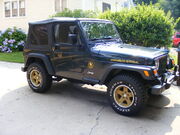
2006 Golden Eagle
- 2007–2009 Wrangler JK
- 2007–2009 JK Rubicon, Sahara, X
- 2010 JK Rubicon, Sahara, Mountain, Islander, Sport
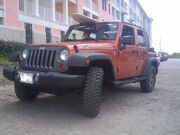
2010 Jeep Wrangler Unlimited Mountain
ZJ, WJ, and WK models
(Jeep Grand Cherokee)
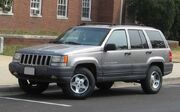
First generation ZJ
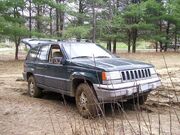
1994 ZJ Laredo Model
- 1993–1998 ZJ Grand Cherokee
- 1993–1995 Base SE
- 1993–1998 Laredo
- 1993–1998 Limited
- 1995–1997 Orvis "Limited Edition"
- 1997–1998 TSi
- 1998 5.9 Limited
- 1993 ZJ Jeep Grand Wagoneer
- 1999–2004 WJ Grand Cherokee
- 2002–2003 Sport
- 2002–2004 Special edition
- 2002–2004 Overland
- 2004 Columbia Edition
- Jeep Grand Cherokee: Five-passenger family-oriented SUV
XK models
- 2006–2010 Jeep Commander
- 2006 Base
- 2007–2010 Sport
- 2006–2010 Limited
- 2007–2009 Overland
KJ models
(Jeep Liberty)
- 2002–2007 KJ Liberty
- Sport
- Limited
- Renegade
- 2003 Freedom Edition
- 2004-05 Rocky Mountain Edition
- 2004 Columbia Edition
- 2006 65th Anniversary Edition
- 2007 Latitude Edition(replaced Renegade)
Current models
The Jeep brand currently produces five models:
- Jeep Wrangler
- JK: The current version of the Wrangler, released as a 2007 model
- JK Unlimited: The long wheelbase, 4-door version of the 2007 Wrangler
- Jeep Grand Cherokee: Five-passenger family-oriented SUV
- Jeep Liberty KK: A small SUV (replaced the Cherokee and kept the name outside North America)
- Jeep Compass MK: A small crossover SUV shared platform with the Dodge Caliber
- Jeep Patriot MK: A small crossover SUV shared platform with the Dodge Caliber
Concept vehicles
- 1958 DJ-3A Pickup
- 1970 XJ001
- 1970 XJ002
- 1971 Jeep Cowboy
- 1977 Jeep II
- 1986 Cherokee Targa: A two-door Cherokee convertible (later revised as Jeep Freedom show car)
- 1987 Comanche Thunderchief: This vehicle was put into production later as the Comanche Eliminator
- 1989 Jeep Rubicon Wrangler: This vehicle was later put in production
- 1990 Jeep JJ: Essentially what would later be called the Icon
- 1990 Jeep Freedom: A revised Cherokee Targa
- 1991 Jeep Wagoneer 2000: A design study be the next generation Wagoneer, but was not put into production
- 1989 Jeep Concept 1: Evolved into the ZJ Grand Cherokee
- 1993 Jeep Ecco
- 1997 Jeep Cherokee Casablanca: A special edition of Cherokee, never produced
- 1997 Jeep Wrangler Ultimate Rescue: A tuned version of a regular TJ Wrangler developed for SEMA show
- 1997 Fender Jeep Wrangler
- 1997 Jeep Dakar: A fused version of a XJ Cherokee and TJ Wrangler
- 1997 Jeep Icon: A design study for the next-generation Wrangler
- 1999 Jeep Journey
- 1999 Jeep Jeepster Concept
- 2000 Jeep Cherokee Total Exposure
- 2000 Jeep Varsity: Subsequently put into production as the Compass
- 2000 Jeep Commander Concept: Subsequently put into production as the XK
- 2000 Jeep Willys
- 2001 Jeep Willys 2
- 2002 Jeep Wrangler Tabasco
- 2002 Jeep Wrangler Patriot: A special decal package for the Wrangler X/Sport
- 2002 Jeep Wrangler Mountain Biker
- 2004 Jeep Grand Cherokee (WJ) Concierge
- 2004 Jeep Treo
- 2004 Jeep Rescue
- 2004 Jeep Liberator CRD
- 2005 Jeep Hurricane: The 4-wheel steering system allows the vehicle to have both a zero turning circle, and "crab" sideways.[25] Its engine was later put in the Grand Cherokee (WK) SRT-8
- 2005 Jeep Gladiator Concept: This vehicle was supposed to be put into production, but Jeep cancelled it
- 2005 Jeep Aggressor (the Rezo)
- 2007 Jeep Trailhawk
- 2008 Jeep Renegade
- 2010 Jeep J8
- 2010 Jeep Nukizer: Design study inspired by the Military Kaiser M-715
Jeeps around the world
Jeeps have been built and/or assembled around the world by various companies.[26]
- Argentina - IKA Jeeps 1956-current; now owned by Chrysler[27]
- Australia - Willys Motors Australia - 1940s-1980s[28]
- Belgium -
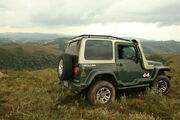
The Troller T4
- Brazil - Willys Overland do Brasil, purchased by Ford to become Ford do Brasil - 1957-1985[29] and the Troller T4 is a fiberglass bodied Jeep version built in Brazil. Troller was purchased by Ford do Brasil in 2007.
- Burma/Myanmar - Two Burmese companies produce unlicensed copies of jeeps; Myanmar Jeeps and Chin Dwin Star Jeeps.
- Canada - Kaiser Jeep - 1959-1969[30]
- China - Beijing Jeep Corporation - 1983 to 2009 as Beijing-Benz DaimlerChrysler Automotive. Fiat-Chrysler plans to re-open Jeep production in China through joint venture with Guangzhou Automobile Industry Group (GAIG).[31]
- Colombia - Willys Colombia - at least until 1999[32]
- Egypt - Arab Organization for Industrialization subsidiary Arab American Vehicles based in Cairo produces the Jeep CherokeeTemplate:Dn; the open-top, Wrangler-based Jeep AAV TJL.
- France - Hotchkiss and Auverland - 1952-1962[33]
- India - Mahindra & Mahindra Limited - 1960s-current[34]
- Iran - Pars Khodro, ShahBaaz, Sahra, and Ahoo - ShahBaaz based on DJ series, Sahra based on Jeep Wrangler and CJ series, and Ahoo based on Wagoneer
- Israel - Automotive Industries which produces the AIL Storm (Sufa) series of Jeep Wrangler-derivatives
- Italy - 1950s[35]
- Japan - Mitsubishi Jeeps - 1953-1998[36]
- Korea - Asia Motors, Ltd, Dong A Motors (SsangYong Motor Company) and Kia. (don't use Jeep name) - 1980s-current[37]
- Mexico - VAM Jeeps - 1946-1987[38]
- Netherlands - Nederlandse Kaiser-Frazer - 1954-1990s[39]
- Philippines - Jeepneys;[40] MD Juan Willys MB.;[41] "E-jeepneys" or minibuses, LSV (low-speed vehicles) which uses electricity.[42][43]
- Portugal - Bravia - 1960s-1980s
- Spain - Vehículos Industriales y Agrícolas, S.A. (VIASA), absorbed by Ebro trucks, and later sold to Nissan - 1960-1990s[44]
- Turkey - Tuzla - 1954-1970s[45]
- Venezuela- Valencia Carabobo 1962-2011, 1962 Tejerias Edo Aragua Willys de Venezuela, S.A, 1979 -2011 Ensambladora Carabobo C.A Valencia Edo Carabobo
See also
| « previous — Jeep road vehicle timeline, 1980s–present | ||||||||||||||||||||||||||||||||
|---|---|---|---|---|---|---|---|---|---|---|---|---|---|---|---|---|---|---|---|---|---|---|---|---|---|---|---|---|---|---|---|---|
| Type | 1980s | 1990s | 2000s | 2010s | ||||||||||||||||||||||||||||
| 0 | 1 | 2 | 3 | 4 | 5 | 6 | 7 | 8 | 9 | 0 | 1 | 2 | 3 | 4 | 5 | 6 | 7 | 8 | 9 | 0 | 1 | 2 | 3 | 4 | 5 | 6 | 7 | 8 | 9 | 0 | 1 | |
| Traditional | CJ-5 | |||||||||||||||||||||||||||||||
| CJ-7 | Wrangler YJ | Wrangler TJ | Wrangler JK | |||||||||||||||||||||||||||||
| CJ-8 | LJ | |||||||||||||||||||||||||||||||
| Dispatcher | DJ-5/6 | |||||||||||||||||||||||||||||||
| Crossover | Compass MK | |||||||||||||||||||||||||||||||
| Patriot MK | ||||||||||||||||||||||||||||||||
| Compact SUV | Cherokee / Wagoneer XJ | Liberty KJ | Liberty KK | |||||||||||||||||||||||||||||
| SUV | Cherokee (SJ) | Grand Cherokee ZJ | Grand Cherokee WJ | Grand Cherokee WK | G.C. WK2 | |||||||||||||||||||||||||||
| Wagoneer SJ | Grand Wagoneer SJ | ZJ | Commander XK | |||||||||||||||||||||||||||||
| Compact pickup | CJ-10 | Comanche MJ | ||||||||||||||||||||||||||||||
| Full-size pickup | Honcho/J10-20 Series | |||||||||||||||||||||||||||||||
- AMC/Jeep Transmissions
- American Motors
- Jeep four wheel drive systems
- Jeep Jamboree: Off Road Adventure, a video game based on the then-current Jeep Wrangler YJ model
- Jeep Thrills
- Jeep parade
- Jeep trail
- Jeepney
- Willys
References
- ↑ "Wordorigins.org". Wordorigins.org. http://www.wordorigins.org/index.php/more/372/. Retrieved 2010-07-04.
- ↑ 2.0 2.1 Statham, Steve (2002). Jeep Color History. MBI Publishing. pp. 26–27. Template:Citation/identifier. http://books.google.com/books?id=dR3wmKlfnrMC&pg=PA26&dq=Jeep+Generic+trademark&hl=en. Retrieved 28 October 2010.
- ↑ Morr, Tom; Brubaker, Ken (2007). The Joy of Jeep. MBI Publishing. p. 50. Template:Citation/identifier. http://books.google.com/books?id=YXow9otLiI8C&pg=PA50&dq=Jeep+Generic+trademark&hl=en. Retrieved 28 October 2010.
- ↑ "The Military Jeep". Cossor.com.au. http://www.cossor.com.au/jeep_1.html. Retrieved 2010-03-12.
- ↑ ""Invention of the Jeep" Waymark". Waymarking.com. 2006-03-09. http://www.waymarking.com/waymarks/WM8NM. Retrieved 2010-08-27.
- ↑ Notman, Robert (2006). Bantam, Ford and Willys-1/4-Ton Reconnaissance Cars. Lulu.com. p. 68. Template:Citation/identifier. http://books.google.com/books?id=Akl0LXTXeT8C&pg=PA68&dq=weight+requirement+Jeep&hl=en. Retrieved 2010-11-30.
- ↑ Allen, Jim (2003). Jeep: Collector's Library. MBI Publishing. pp. 36–39. Template:Citation/identifier.
- ↑ Scott, Graham (1996). Essential Military Jeep: Willys, Ford & Bantam models 1941–45. MBI Publishing Company. p. 25. Template:Citation/identifier.
- ↑ Zaloga, Steven J. (2005). Jeeps 1941–45. Osprey Publishing. p. 10. Template:Citation/identifier.
- ↑ Leigh Brown, Patricia, "Where Do You Hang The 747?", The New York Times, December 13, 1998
- ↑ "New Acquisitions—Smart Car, Volkswagen “Beetle,” and Willys-Overland Jeep—Join Three Other Automobiles in MoMA’s Collection". The Museum of Modern Art. June 2002. Archived from the original on 2011-08-25. http://web.archive.org/web/20110825023059/http://press.moma.org/images/press/PRESS_RELEASE_ARCHIVE/AUTO.pdf. Retrieved 2010-11-30.
- ↑ R. Cole, "Chairman Offers to Buy Coleman", The New York Times, Page D1, Feb. 15, 1989.
- ↑ "Mitsubishi Jeep Photos on The CJ3B Page". Film.queensu.ca. 2002-08-29. http://www.film.queensu.ca/cj3B/World/JapanPhotos.html. Retrieved 2009-09-23.
- ↑ Mann, Jim (1997). Beijing Jeep: A Case Study of Western Business in China. Perseus. Template:Citation/identifier.
- ↑ Dunne, Timothy (2007-11-02). "Can Chrysler Rebound in China?". Business Week. http://www.businessweek.com/globalbiz/content/nov2007/gb2007112_737100.htm. Retrieved 2010-10-26.
- ↑ "Toledo-built Jeeps' sales results abroad mirror those in North American market". News.top100.biz. 2007-11-13. http://news.top100.biz/shopping/Toledo-built-Jeeps-sales-results-abroad-mirror-those-in-North-American-market/. Retrieved 2010-07-04.
- ↑ "Jeepster VJ - - Jeep at Off-Road.com". Jeep.off-road.com. http://jeep.off-road.com/jeep/article/articleDetail.jsp?id=261018. Retrieved 2009-09-23. Template:Dead link
- ↑ https://archive.is/20120717184306/www.americanjeepsterclub.org/history/hist1.jpg
- ↑ https://archive.is/20120804053650/www.americanjeepsterclub.org/history/hist2.jpg
- ↑ https://archive.is/20120717201345/www.americanjeepsterclub.org/history/hist3.jpg
- ↑ https://archive.is/20120720195453/www.americanjeepsterclub.org/history/49coupe.jpg
- ↑ https://archive.is/20120730161200/www.americanjeepsterclub.org/history/proto.jpg
- ↑ https://archive.is/20120719084252/www.americanjeepsterclub.org/history/proto2.jpg
- ↑ https://archive.is/20120717191021/www.americanjeepsterclub.org/history/proto3.jpg
- ↑ "Jeep 4-wheel steering". http://autoweek.com/apps/pbcs.dll/article?AID=/20050109/FREE/501090708&SearchID=7326899736199. Retrieved 2007-01-12.
- ↑ "Jeeps Around the World on The CJ3B Page". Film.queensu.ca. 2009-01-31. http://www.film.queensu.ca/Cj3b/World.html. Retrieved 2010-07-04.
- ↑ "Jeeps in Argentina on The CJ3B Page". Film.queensu.ca. 2005-02-06. http://www.film.queensu.ca/Cj3b/World/Argentina.html. Retrieved 2010-07-04.
- ↑ "Jeeps in Australia on The CJ3B Page". Film.queensu.ca. http://www.film.queensu.ca/Cj3b/World/Australia.html. Retrieved 2010-07-04.
- ↑ "Jeeps in Brasil on The CJ3B Page". Film.queensu.ca. http://www.film.queensu.ca/Cj3b/World/Brasil.html. Retrieved 2010-07-04.
- ↑ "Kaiser Jeep in Canada 1959-69 on The CJ3B Page". Film.queensu.ca. http://www.film.queensu.ca/Cj3b/Canada/CanadaKaiser.html. Retrieved 2010-07-04.
- ↑ "Fiat to Re-introduce Jeep to China". ChinaAutoWeb.com. 2010-05. http://chinaautoweb.com/2010/05/fiat-to-re-introduce-jeep-to-china/.
- ↑ "Jeeps in Colombia on The CJ3B Page". Film.queensu.ca. 2010-03-22. http://www.film.queensu.ca/Cj3b/World/Colombia.html. Retrieved 2010-07-04.
- ↑ "Jeeps in France on The CJ3B Page". Film.queensu.ca. 2008-09-17. http://www.film.queensu.ca/Cj3b/World/France.html. Retrieved 2010-07-04.
- ↑ "Mahindra Jeeps on The CJ3B Page". Film.queensu.ca. 2007-01-31. http://www.film.queensu.ca/Cj3b/World/India.html. Retrieved 2010-07-04.
- ↑ "Jeeps in Italy on The CJ3B Page". Film.queensu.ca. 2009-03-24. http://www.film.queensu.ca/Cj3b/World/Italy.html. Retrieved 2010-07-04.
- ↑ "Jeeps in Japan on The CJ3B Page". Film.queensu.ca. 2009-01-31. http://www.film.queensu.ca/Cj3b/World/Japan.html. Retrieved 2010-07-04.
- ↑ "Jeeps in Korea on The CJ3B Page". Film.queensu.ca. 2006-11-02. http://www.film.queensu.ca/Cj3b/World/Korea.html. Retrieved 2010-07-04.
- ↑ "Jeeps in Mexico on The CJ3B Page". Film.queensu.ca. 2002-07-25. http://www.film.queensu.ca/Cj3b/World/Mexico.html. Retrieved 2010-07-04.
- ↑ "Jeeps in the Netherlands on The CJ3B Page". Film.queensu.ca. http://www.film.queensu.ca/Cj3b/World/NEKAF.html. Retrieved 2010-07-04.
- ↑ "Jeepneys of the Philippines on The CJ3B Page". Film.queensu.ca. 2005-04-27. http://www.film.queensu.ca/Cj3b/World/Philippines.html. Retrieved 2010-07-04.
- ↑ (AFP) – Jun 30, 2008 (2008-06-30). "Afp.google.com, Philippine firm brings old WWII jeeps back to life". Afp.google.com. Archived from the original on 2008-12-08. http://web.archive.org/web/20081208200848/http://afp.google.com/article/ALeqM5gv2YSHd1cglmC-_4BZGymtU4jL8A. Retrieved 2010-07-04.
- ↑ The Earthtimes (2008-07-01). "earthtimes.org, Electric minibuses start commercial operations in Philippines". Earthtimes.org. http://www.earthtimes.org/articles/show/216052,electric-minibuses-start-commercial-operations-in-philippines.html. Retrieved 2010-07-04.
- ↑ "manilastandardtoday.com, Enforcers to drive E-jeeps". Manilastandardtoday.com. http://www.manilastandardtoday.com/?page=police1_june30_2008. Retrieved 2010-07-04.
- ↑ "Jeeps in Spain on The CJ3B Page". Film.queensu.ca. 2009-02-12. http://www.film.queensu.ca/Cj3b/World/Spain.html. Retrieved 2010-07-04.
- ↑ "Jeeps in Turkey on The CJ3B Page". Film.queensu.ca. 2005-11-22. http://www.film.queensu.ca/Cj3b/World/TurkeyTuzla.html. Retrieved 2010-07-04.
